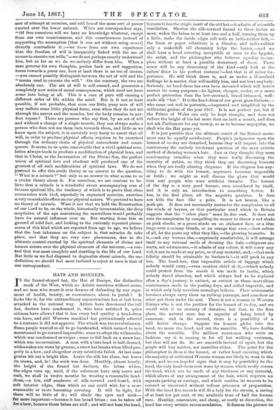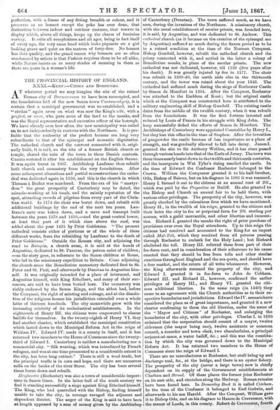HATS AND BONNETS.
TS the funnel-shaped hat, the Hat of Europe, the distinctive I mark of the West, which no Asiatic mentions without scorn, and no man who wears it ever dreams of defending by any argu- ment of health, beauty, or convenience, about to perish ? It looks like it, for the extraordinary superstructure has at last been attacked in the rational way. Artists have denounced the tall hat, doctors have condemned it, wits have satirized it, quiet .citizens have allowed that it has every bad quality a head-dress can have, and still Western mankind has pertinaciously adhered to a costume it did not approve. The attack was too revolutionary. Some people wanted us all to go bareheaded, which seemed to men accustomed to go covered impossible; some to adopt the wideawake, which was condemned as vulgar ; some to fall back on a straw hat, which was inconvenient. A man with a bare bead is half-dressed, wideawakes are worn by grooms, a straw hat breaks when lifted pro- perly in a bow, and altogether every substitute failed. At last some genius hit out a bright idea. Leave the silk hat alone, but lower its crown, and, lo ! the work was done. Monthly, almost hourly, the height of the funnel hat declines, the brims widen, the edges turn up, until, if the reformers have only nerve and cash, we shall in twelve months be wearing a reasonable head- dress,—a low, stiff sombrero of silk-covered card-board, with soft interior edges, than which no one could wish for a more reasonable or more becoming covering. It will be light, for there will be little of it ; will shade the eyes and neck— far more important—because it has broad brims ; can be taken off for a bow, because those brims are stiff ; and will not heat the head, because it has the single merit of the old hat—it admits of scientific ventilation. Shorten the silk-covered funnel to three inches at most, widen the brims to at least two and a half, turning them up a little, make the inside edges soft with an india-rubber belt,— the linen or paper substitute is a blunder, Ad india-rubber only a makeshift till chemistry helps the hatter,—and we shall have a head covering acceptable at once to the hygeist, the artist, and the philosopher who believes equality incom- plete without at least a possible democracy of dress. There never will be any democracy of the kind—only look at the tailors' fitter in his perfect costume !—but that is of minor im- portance. He will think there is, and as under a Household Suffrage he is master, that will mollify him, and not hurt anybody. Seriously, no head-dress has ever been invented which will better answer its many purposes—be lighter, cheaper, cooler, or a more perfect proteetion than the low-crowned, broad-brimmed, well- made silk "hat." It is the head-dress of our great grandfathers,— who came out well in portraits,—improved and simplified by the utilitarian genius of the year 1867. It is not perfect yet, but if the Prince of Wales can only be kept straight, and does not reduce the height of his hat more than an inch a month, and does not ask Parliament for any money, so as to become unpopular, we shall win the Hat game yet.
It is just possible that the ultimate result of the Bonnet move- ment may be equally satisfactory. People's judgments upon the bonnet of to-day are disturbed, because they will import into the controversy the entirely irrelevant question of the most artistic method of dressing women's hair. Just as they thought they were condemning crinoline when they were really discussing the morality of ankles, so they think they are discussing bonnets when they are really abusing chignons. If the chignon has any- thing to do with the bonnet, argument becomes impossible or futile ; we might as well discuss the glove that would best suit people who wore artificial thumbs. The bonnet of the day is a very good bonnet, even considered by itself, and it is only an introduction to something batter. It has, in the first place, all the negative qualities. It does not hide the face like a poke. It is not brazen, like a pork-pie. It does not necessarily surrender the complexion to all
the winds of heaven, or that particular wind which in Britain suggests that the " other place " must lie due east. It does not ruin the complexion by compelling its wearer to throw a red shade on pink cheeks, or a green shade on an alabaster face, or a blue tinge over a creamy blonde, or an orange tint over,—best colour of all, let the poets say what they like,—the glowing brunette. It is,—ask any woman else,—supremely comfortable, it will arrange itself to any rational mode of dressing the hair, —chignons are warts, not adornments,—it admits of any colour, it will carry any veil, it can be made at any price, or of any material, and,—that such felicity should be attainable to husbands I—it will pack in any box. The band-box, that impossible article of luggage which nobody would carry,—even couriers shied at it, —which nobody could protect from the smash it was made to invite, which nobody dared abandon, and which always had to be replaced after a day's journey, is extinct, as extinct as those marvellous contrivances made in the posting days, and called imperials, and in which only lady novelists nowadays believe. Their aristocratic heroines always carry them on railway journeys, and somehow or other get them under the seat. There is not a woman in Western Europe who is not the prettier for the bonnet of to-day, and we would wish it an eternity of duration, but that, in the first place, the natural man has a capacity of being bored by sameness ; and in the second, there is a possibility of a. still better change. Suppose the bonnet glides into the hood, we mean the hood, and not the mantilla. We have doubts about the mantilla. The milliner countesses who write on fashions say it is coming in for all but walking costumes, but that will not do. So are emeralds instead of opals, but the people will buy neither, nor mantillas either. The point for the philosopher in dress is the bonnet, or rather head covering which the majority of cultivated Western women are likely to wear in the street, and we see hopeful signs that it may by possibility be the hood, the only head-dress ever worn by women which really covers the head, which can be made of any thickness or any material, which allows of any arrangement of the hair, which requires no separate packing or carriage, and which enables its wearers to be covered or uncovered without tedious processes of preparation. With the hood five seconds will fit a lady for the streets, a saving of at least ten per cent. of the available time of half the human. race. Healthy, convenient, and cheap, or costly at discretion, the hood has every artistic recommendation. It frames the picture to
perfection, with a frame of any fitting breadth or colour, and it preserves as no bonnet except the poke has ever done, that distinction between indoor and outdoor costume, that reserve in display which, above all things, keeps up the charm of feminine variety. It suite all complexions and all ages, being in fact itself of every age, the very same hood which looks piquante on a girl looking grave and quiet on the matron of forty-five. No bonnet has that quality, and the grand reason why bonnets are so often condemned by artists is that Fashion requires them to be all alike, while Nature insists on as many shades of meaning in them as there are years in a woman's life.































 Previous page
Previous page